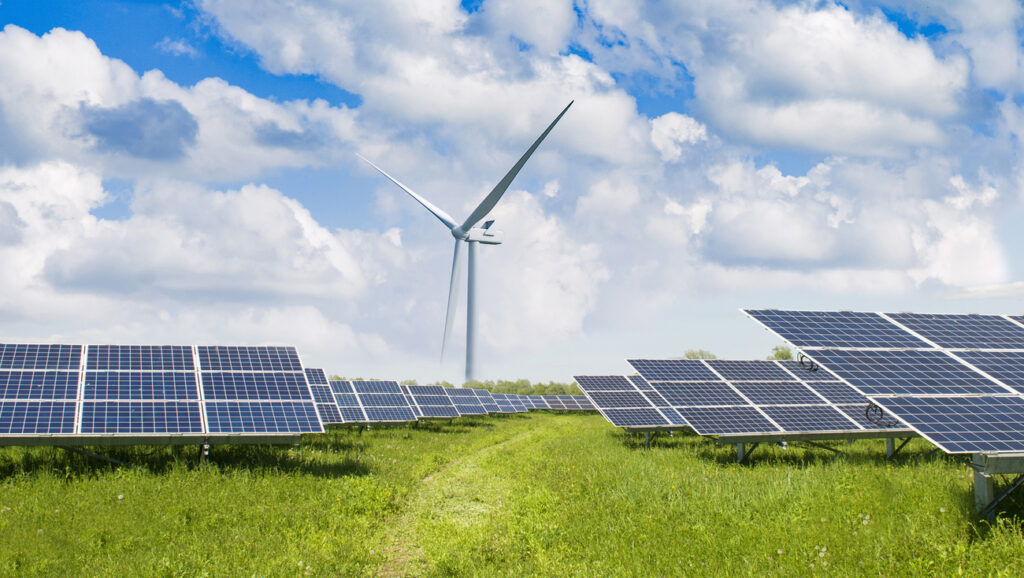Hybridization of Renewable Energies
The Energy Transition Linked to Renewable Hybridization
The hybridization of renewable energy sources represents a key advancement in the pursuit of sustainability and the transition toward cleaner, more efficient energy systems. By combining various renewable sources such as solar, wind, or solar thermal with storage technologies, it is possible to maximize energy production, reduce dependence on fossil fuels, and optimize available natural resources. This approach not only enables more efficient electricity generation but also minimizes intermittency issues and ensures a more stable and reliable power supply, significantly contributing to carbon footprint reduction.
What is Renewable Energy Hybridization?

– Definition and Basic Principles
Renewable energy hybridization involves integrating different energy generation technologies—such as photovoltaic solar, wind, concentrated solar power (CSP), or even biomass—into a single system to leverage the strengths of each source. This approach maximizes energy efficiency by combining resources that are typically available at different times of day or under varying weather conditions.
– Advantages of Hybrid Systems in the Energy Sector
Hybrid systems offer multiple benefits, including:
Reduced energy intermittency: When one source is unavailable, another can meet the demand.
Higher overall performance: Infrastructure and land use are optimized, as different technologies can share space.
Operational flexibility: By integrating storage systems, such as batteries or thermal energy storage, production can be better managed to meet demand.
– Impact on Sustainability and Carbon Footprint Reduction
Hybridization is a key strategy for decarbonizing the energy sector. By combining clean energy technologies, reliance on non-renewable sources is reduced, thereby lowering CO₂ emissions. Moreover, the use of hybrid systems promotes more efficient use of natural resources, supporting a more sustainable and environmentally friendly energy model.
Types of Hybrid Renewable Energy Systems
Hybridization of renewable sources is an advanced technological solution that maximizes the efficiency of energy systems by combining different clean energy sources. These systems stand out for their ability to leverage the strengths of each technology, mitigating intermittency issues and ensuring a more stable and sustainable energy supply.

1. Hybridization of Wind and Photovoltaic (PV) Energy
The combination of wind energy and photovoltaic (PV) solar energy is one of the most widespread solutions in the renewable energy sector. These systems are designed to take advantage of the differing generation patterns of both sources:
Solar energy: Primarily produces electricity during the day, especially under high solar irradiance conditions.
Wind energy: Tends to generate power more consistently, particularly at night or under optimal wind conditions.
This synergy reduces intermittency and improves the stability of electricity supply, making hybrid systems especially useful in regions with variable weather conditions. Additionally, they are ideal for isolated grids or areas with limited access to transmission infrastructure, enabling sustainable energy access.
2. Hybridization of Concentrated Solar Power (CSP) and Photovoltaic (PV) Energy with Thermal Energy Storage
This type of hybridization combines CSP with PV and advanced thermal energy storage systems, maximizing energy output and enabling continuous power supply even when solar irradiance is absent.
Use of Molten Salts as Thermal Storage
In conventional energy storage systems, molten salts are used as a thermal storage medium due to their capacity to retain large amounts of heat at high temperatures. This method is commonly employed in CSP plants, where heat captured by concentrator mirrors or heliostats heats the salts to temperatures exceeding 500 °C. The stored heat is later used to generate steam and drive turbines, producing electricity efficiently and flexibly.
Heating Molten Salts with HTF and Then with Photovoltaic Energy
One of the latest innovations in hybridization combines the use of HTFs (Heat Transfer Fluids) to initially heat the molten salts to around 380–400 °C. The HTF is heated in a CSP plant, typically using parabolic trough technology, and transfers its thermal energy to the salts through a heat exchanger.
This process is later complemented by photovoltaic energy, which—via an electric heater—raises the temperature of the salts even further, thereby increasing the efficiency of thermal-to-electric conversion in a steam turbine. This approach not only optimizes the use of available technologies but also allows maximum utilization of solar panel electricity during peak production periods.

This type of hybridization represents a significant step forward in the pursuit of more sustainable and efficient energy systems, ensuring a stable and continuous supply with a reduced environmental impact.
4. Hybridization of Renewable Energy and Biomass
The hybridization of renewable energy with biomass combines clean, intermittent sources such as photovoltaic solar or wind energy with biomass, a dispatchable and continuous energy source. This integration helps overcome the limitations of intermittent renewables, as biomass serves as a backup to ensure a constant supply.
In these systems, renewable energy generates electricity when weather conditions are favorable, while biomass steps in during periods of low renewable output. Moreover, biomass is used not only to generate electricity via boilers or steam turbines but also to produce useful heat for industrial processes, enhancing the overall efficiency of the hybrid system. This approach is particularly valuable in rural areas or agricultural industries, where local organic waste can be used as raw material.
5. Integration of Green Hydrogen Systems with Hybrid Renewables
Green hydrogen, produced through electrolysis using electricity from renewable sources, is emerging as a key component in hybrid energy systems. In these setups, energy generated by technologies such as photovoltaic solar, wind, or concentrated solar power is used to produce hydrogen, which serves as both an energy storage medium and a secondary energy source.
During periods of high renewable generation, surplus energy is used to produce hydrogen. This hydrogen can later be used as fuel in gas turbines or fuel cells to generate electricity when renewable output is low. Additionally, green hydrogen, when hybridized with other renewable energy sources, offers an ideal solution for decarbonizing sectors like heavy transport and industry, where direct electrification options are limited.
Integrating renewables in this way not only improves the stability of hybrid systems but also significantly contributes to carbon emission reductions and the development of a more resilient and sustainable energy system.
Advantages of Renewable Energy Hybridization
Optimization of the Use of Natural Resources
Hybridization of renewable energies allows for a more efficient use of available natural resources such as sunlight, wind, and biomass. By combining technologies like photovoltaic solar and wind energy, higher energy production is achieved based on the climatic and geographic conditions of each location. This means that the energy potential of an area can be maximized, reducing reliance on external sources and promoting local sustainability.
Reduction of Intermittency in Renewable Energies
One of the biggest challenges of renewable energies is their intermittency. Combining sources like solar, wind, and biomass helps balance energy generation, ensuring a continuous supply even when one of the sources is unavailable. For example, during the night or on cloudy days, wind energy or biomass can compensate for the lack of solar production, ensuring greater stability in the electricity supply.
Increased Efficiency in the Use of Existing Infrastructure
Hybrid systems allow for more efficient use of already installed infrastructure, such as transmission lines, storage systems, or existing plants. This not only reduces costs associated with building new infrastructure but also improves the profitability of renewable projects by increasing their generation capacity without requiring significant additional investments.
Aplicaciones de los Sistemas Híbridos en Energías Renovables

Hybrid Plants for Electricity Generation
Hybrid plants combine various technologies, such as photovoltaic solar, concentrated solar power, and wind energy, to maximize electricity generation. These facilities are ideal for regions with varied renewable resources, allowing one energy source to compensate for the low production of another. For example, a hybrid solar-wind plant can consistently produce electricity by harnessing both daytime sunlight and nighttime winds.
Energy Storage in Hybrid Systems
Energy storage is an essential component of hybrid systems, as it allows surplus renewable generation to be stored for later use. Technologies such as thermal energy storage in molten salts or advanced batteries are often integrated into these configurations to ensure a stable supply and make the most of the energy produced. This approach is key to decarbonizing the power grid and improving energy resilience.
Use of Hybrid Systems in Industrial Projects
In the industrial sector, hybrid systems offer highly efficient energy solutions. The combination of renewable energy with manageable sources such as biomass or green hydrogen enables the provision of heat, electricity, and cooling for industrial processes. This is especially relevant in sectors like mining, manufacturing, and agroindustry, where hybrid systems reduce energy costs, improve sustainability, and ensure a reliable energy supply even in remote locations.
Renewable
Power Onwards
Engineers with over 20 years of experience
